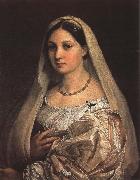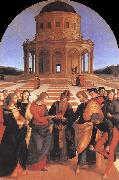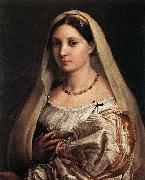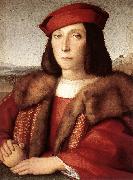|
Here are all the paintings of Raffaello 04
| ID |
Painting |
Oil Pantings, Sorted from A to Z |
Painting Description |
| 55703 |
 |
Wearing veil woman |
mk243
1516
Oil on board
|
| 55641 |
 |
Wedding |
mk243
1504
170x117cm
Oil on board
|
| 63780 |
 |
Woman with a Veil |
1516 Oil on canvas, 82 x 60,5 cm Galleria Palatina (Palazzo Pitti), Florence Tradition identifies the subject with "la Fornarina", the woman whom the painter loved in his last years and whose face reappeared in both his paintings (e.g. in the Sistine Madonna) and those of his followers. However, the woman, has never been decisively identified. She seems to represent Raphael's ideal of beauty at this time. The painting shows greater attention to colour and to the rendering of skin and clothes in respect to previous female portraits. The regular oval of the young woman's face stands out against the dark background and her eyes hold an intense and penetrating look. The silk of her sleeves contrasts with her ivory-like skin, and is closely associated with the thin pleating of the dress, held up by a corset with golden embroidery. As in the portrait of Castiglione, the figure radiates a sense of great dignity and restraint. But greys and light-blues dominated the portrait of Castiglione: here the warm tonalities of white and gold take over. Raphael is preparing the wider colour range and the more complex composition which will be expressed in the Portrait of Leo X.Artist:RAFFAELLO Sanzio Title: Woman with a Veil (La Donna Velata) Painted in 1501-1550 , Italian - - painting : portrait |
| 8727 |
 |
Young Man with an Apple |
1505
Oil on wood, 47 x 35 cm
Galleria degli Uffizi, Florence |
| 88336 |
 |
Young Man with an Apple |
1505(1505)
Medium Oil on wood
cyf |
|
|
|
Prev 1 2 3 4
|
|
| Raffaello
|
| Italian painter , 1483-1520
was an Italian painter and architect of the High Renaissance, celebrated for the perfection and grace of his paintings and drawings. Together with Michelangelo and Leonardo da Vinci, he forms the traditional trinity of great masters of that period. Raphael was enormously productive, running an unusually large workshop, and, despite his early death at thirty-seven, a large body of his work remains, especially in the Vatican, whose frescoed Raphael Rooms were the central, and the largest, work of his career, although unfinished at his death. After his early years in Rome, much of his work was designed by him and executed largely by the workshop from his drawings, with considerable loss of quality. He was extremely influential in his lifetime, though outside Rome his work was mostly known from his collaborative printmaking. After his death, the influence of his great rival Michelangelo was more widespread until the 18th and 19th centuries, when Raphael's more serene and harmonious qualities were again regarded as the highest models.
|
|


